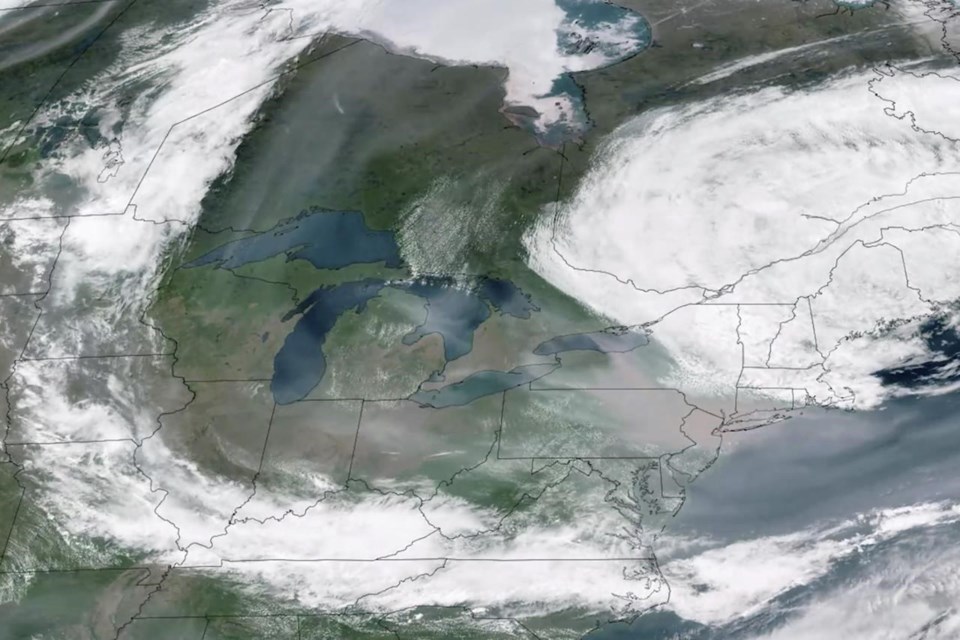Smoke and flames continue to engulf much of Canada with poor air quality in parts of Ontario and Quebec and the same blanketing much of the west. Here's a look at developments Friday:
Poor air quality from fires expected to continue in some areas
Wildfire smoke that hung over Toronto for several days has cleared, resulting in a notable improvement in air quality for Canada's most populous city, but the haze is persisting in western Quebec, Saskatchewan, Alberta and parts of British Columbia.
Parts of northern Ontario are experiencing the effects of wildfire smoke, with Environment Canada warning of high levels of air pollution in communities including North Bay, Sudbury and Timmins.
Moderately bad air quality is forecast for Edmonton and Calgary, but the worst air in Alberta is near Fort Chipewyan, which remains on an evacuation order as a fire there burns out of control.
Air quality alerts are in place for the western half of Saskatchewan after wildfire smoke returned to that province.
In B.C., air quality is expected to improve almost everywhere in the province except for Fort St. John.
Firefighters arrive from France to help in Quebec
The arrival of firefighters from France and New Brunswick is expected to bolster efforts to contain and control the large number of fires burning across Quebec in what's expected to be a marathon wildfire season.
Maïté Blanchette Vézina, the province's minister of forests and natural resources, says the situation remains critical but is improving.
Efforts in the coming days should permit firefighters to contain and begin extinguishing some of the approximately 140 fires that remain active across the province.
Officials expect about 1,200 people will be fighting fires in the province by Monday, including hundreds of firefighters from the United States, Portugal and Spain, who are expected to arrive in the coming days.
U.S. happy to help Canada while looking towards domestic fire season
The United States has provided help to Canada to beat back the fearsome wildfire season, but officials say they are watching to see when those resources will be needed closer to home.
There are currently 345 federally co-ordinated firefighters and support personnel operating in Canada but the number is expected to fluctuate as workers cycle back through the U.S.
That number doesn't include state-level resources that are also assisting.
Jeff Arnberger, with the U.S. National Interagency Fire Center, says they've been fortunate to have a slow start to the fire season this year but they must also be prepared for wildfires in the U.S.
Eyes on the weather as fierce B.C. wildfire rages
Expected showers on Saturday could sprinkle an aggressive wildfire that has forced more than 2,000 people from their homes in northeastern B.C.
But forecasters say thunderstorms could sweep the parched region before any rain arrives.
Environment Canada says thunderstorms in the Tumbler Ridge and Dawson Creek areas have come with heavy smoke and temperatures almost 10 C above normal.
The extreme fire activity prompted the District of Tumbler Ridge to skip an evacuation alert Thursday and jump right to an order, requiring all residents to get out immediately.
There are 83 active wildfires in the province, including the nearly two-square-kilometre fire that has closed the Vancouver Island highway connecting Port Alberni, Tofino and Ucluelet to the rest of the Island.
Evacuation orders lifted in southwestern Nova Scotia
Evacuation orders have been lifted in Nova Scotia's Shelburne County, where the largest wildfire in the province's history continues to burn out of control but hasn't grown since last weekend.
The wildfire, which started May 27 near Barrington Lake, forced more than 6,000 people to flee and destroyed 60 homes and cottages, as well as 150 other structures.
The fire has grown to 235 square kilometres, but officials say firefighting efforts have been helped by heavy rains and cool weather.
Meanwhile, almost all evacuation orders have been lifted for residents in Halifax subdivisions that sustained major damage when a fast-moving wildfire broke out two weeks ago and destroyed 150 houses.
Wildfires, smoke affecting tourism industry
Raging wildfires and smoky skies have put a damper on travel this summer, resulting in cancelled plans and closed businesses.
Madison Simmons with the Tourism Industry Association of Ontario says members have reported domestic and international visitors cancelling trips, especially in the northern part of the province.
In neighbouring Quebec, fires and restrictions have caused many wilderness outfitters to shut down during one of their busiest times of the year.
Dominic Dugré, president of industry association Fédération des pourvoiries du Québec, says that of the more than 500 outfitters operating in Quebec's forests, 350 have been forced to close.
This report by The Canadian Press was first published June 9, 2023.
The Canadian Press



